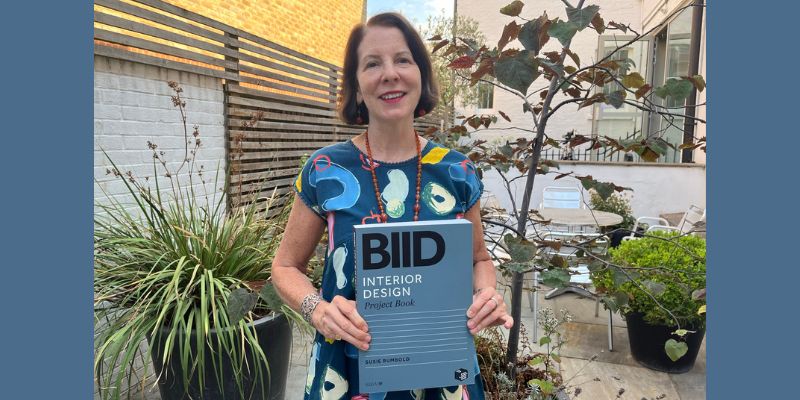BIID Interior Design Project Book – the must have resource for Interior Designers

Karen Haller

Within the interior design community here in the UK, mention the name Susie Rumbold and chances are you’ll have heard of her.
Susie set up her own interior design practice nearly 30 years ago and over that time has had a broad portfolio working on both commercial and residential projects specialising in listed buildings and heritage structures including grade I listed buildings.
Back in 2016 she was President of BIID (British Institute of Interior Design) and following that she was part of the team that negotiated the new joint contracts between the RIBA (Royal Institute of Architects) and the BIID.
It was in 2016 that Susie and I met when I was a guest at a BIID function. And as a fellow Australian, we naturally got chatting. As the event was ending Susie ‘kidnapped’ me (her words!) and took me to Mill Bank where she blagged our way into the Abbott and Boyd private party, and we have been friends ever since.
Our friendship aside, Susie is someone I highly respect for her experience, professionalism, and dedication to her craft. So, when I heard that her book had been published, I knew I had to interview her and share her insider wisdom with you!
So last week we met up at St Christopher’s Place in London and over a delicious Turkish Meze we chatted about this incredible resource she had created for professionals in the built environment.
Karen Haller: Why did you decide to write the book?
Susie Rumbold: When the RIBA and BIID approached me to write the book, I had a look around and I really felt that there was a gap in the market for something like this. It is a complete end to end tome on professional practice for interior designers starting with first principles, how to set up a business, and working right through to the installation of the last tassel. This gap was the driver for it, and it was one of those things that absolutely grew in the telling. It started as book detailing how interior design fits into the new 2020 RIBA Plan of work and morphed into a bigger beast as I realised how much other stuff there was that designers needed to know.
Karen_ What gap did you see to write this book? Does it cover what you’re not taught in interior design courses?
Susie_ There is a lot that’s not taught in interior design education and the book attempts to cover off some of those areas. I have some sympathy with people that write degree courses because interior design is such an incredibly broad subject. There’s so much to teach students in a three-year degree course or five years if it’s a masters. There’s isn’t the time to cover it all.
Not everyone who qualifies as an interior designer and then goes into the industry is going to need the professional practice side. Some will go to big architect practices, others in-house interior designers for development companies, some may go into branding or wayfinding. There are a million different things that people can do with an interior design qualification. Every building, every space we walk into has been designed by someone and not every one of them is going to need to know about fee proposal and contracts, so I don’t think it’s an issue that these aren’t covered in interior design education, but nevertheless, there must be somewhere people go to find the information when they do need it.
Karen_ Do you feel what you covered in the book is not part of interior design courses, and do you think because you have real life work experience, you’re able to give a different view?
Susie_ I absolutely agree. I don’t think most of this is covered in interior design courses. As I was just saying, in a way it doesn’t need to be. Most interior design degree courses only touch on professional practice in the most glancing of ways – giving students a sense of things that professional interior designer may have to be concerned with. To be honest, it’s not something that you can teach. Until you’re out there doing it for real, you don’t know what situations are going to arise or what you’re going to be called upon to do and what you’re going to need to know. My aim for this is that it will become the go-to book whenever designers have something that they need to check on.
This is a resource, not just a book that sits on the shelf. I can imagine designers filling it was colourful post-it notes and scribbled notes throughout. That’s a good sign!
“Interior designers have a lot to consider, and the book underpins the professionalism of anyone in the industry who takes their job seriously.”
susie rumbold
Karen_ The information that you cover in the book is extensive and it just shows the depth of knowledge a professionally trained interior designer needs. Do you feel the role of the interior designer is misunderstood, as it seems that the line between a home stylist, interior decorator and interior design has become very blurred?
Susie_ Yes, I think you’re right. To be honest, one of my key drivers in writing the book was to produce a tome that illustrated just how much a professionally trained interior designer needs to know to do their job well and to keep the public safe.
There’s a lot of information in the book about things like fire safety, designing for ergonomic and anthropometric correctness, designing for inclusion, building regulations, and building consents and licenses. There’s even a section about protecting the wildlife you might find living in the buildings that you work on. Interior designers have a lot to consider, and the book underpins the professionalism of anyone in the industry who takes their job seriously.
Karen_ What will long-time experienced interior designers gain from reading your book?
Susie_ I think even really experienced interior designers will not necessarily have encountered every possible situation. I certainly haven’t. I’m learning every day. Even after 30 years, there’s not a week goes past when I don’t trip across something that I’ve never encountered before. What this book will give experienced interior designers is an opportunity to go back and fact check and double check to make sure that they are pursuing best practice in all aspects of their businesses.
Karen_ Will this book be of benefit to architects?
Susie_ An enormous number of architectural practices these days employ in-house interior designers. I think just having the book hanging around the office will first, make the architects appreciate the role of the interior designers they employ and understand how complex the role is. And second, make them realise how much crossover there is between the interior design and the architectural professions. We’re all in the same game. We are all wanting to produce the best possible outcomes for our clients. Some architects may just buy the book to find out what the interior designers that they work with should be doing, so in a way, it may end up being a stick with which to beat less professional interior designers.
Karen_ Will this book be relevant to interior designers anywhere in the world?
Susie_ Obviously parts of the book are UK specific such as UK building and planning regulations and other sections that are UK based. However, when I planned what would go in this book, I discussed with RIBA, and they agreed that we should make it as non-jurisdictional as possible. Even if those regulations don’t apply in the country where the interior designer is working, chances are there will be something extremely similar or equivalent. They just need to go and find out what the regulations are and make sure they check and comply with any local or national legislation. I think the principles in terms of communications and the organisational skills needed to work as part of a team or deal effectively with clients, are universal.
My hope is the book will be adopted as a reference worldwide. It’s already had very good reviews in Australia.
“I hope this book will elevate the standards and champion best practise in interior design and in the general built environment globally.”
susie rumbold
Karen_ Not every country has colour contrast guidelines. If a designer finds there isn’t a particular guideline in place, could they use this used as best practice?
Susie_ Absolutely. I hope this book will elevate the standards and champion best practise in interior design and in the general built environment globally.
We wrapped up the interview with me asking Susie given her 30+ year career if she saw herself as one of the shapers of interior design in the UK, she chuckled as she shared one of her analogies that she coined over 20 years ago which she uses to explain the difference between interior design and interior decorating/styling. “If you take a building and peel off the roof and turn it upside down and give it a good shake, whatever falls out is the interior decoration and whatever stays stuck to the building is the interior design.”
I’ve lost count the number of times I’ve heard this analogy. It’s so common place now. I would say Susie is definitely an industry shaper and going through this book, I wholeheartedly believe that even more now. This book is an incredible resource for interior designers and architects who are running their own business. It is packed with Susie’s 30 years of experience, and I believe it will become the go-to business bible for people in the industry.
If you would like to buy a copy of the book, you can do that through the links below.
Once you have bought the book, I’d love to know what you thought and how it helped you.
Colourfully yours,
Karen
Purchase the book: RIBA, Amazon* and all good bookstores.
Image credit: Tessuto Interiors Ltd.
*Affiliate link


